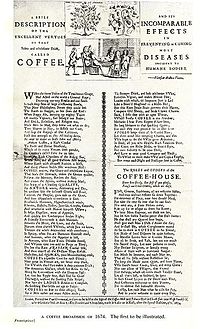
Back المقاهي الإنجليزية في القرنين السابع عشر والثامن عشر Arabic コーヒー・ハウス Japanese Английские кофейни (XVII—XVIII) Russian

In 17th- and 18th-century England, coffeehouses served as public social places where men would meet for conversation and commerce. For the price of a penny, customers purchased a cup of coffee and admission. Travellers introduced coffee as a beverage to England during the mid-17th century; previously it had been consumed mainly for its supposed medicinal properties. Coffeehouses also served tea and hot chocolate as well as a light meal.
The historian Brian Cowan describes English coffeehouses as "places where people gathered to drink coffee, learn the news of the day, and perhaps to meet with other local residents and discuss matters of mutual concern."[1] The absence of alcohol created an atmosphere in which it was possible to engage in more serious conversation than in an alehouse. Coffeehouses also played an important role in the development of financial markets and newspapers.
Topics discussed included politics and political scandals, daily gossip, fashion, current events, and debates surrounding philosophy and the natural sciences. Historians often associate English coffeehouses, during the 17th and 18th centuries, with the intellectual and cultural history of the Age of Enlightenment: they were an alternate sphere, supplementary to the university. Political groups frequently used coffeehouses as meeting places.
- ^ Cowan, 2005. p 79
© MMXXIII Rich X Search. We shall prevail. All rights reserved. Rich X Search